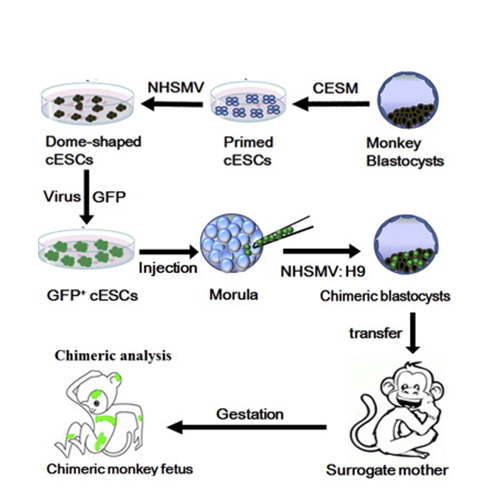

20th November 2023 (11 Topics)
Context
In a recent landmark study, scientists reported successfully generating a live chimaera in non-human primates.
Background
- At present, more than 3 lakh people are waiting for an organ transplant in India alone; the global number is far higher, with no respite in sight.
- There is an alarming disparity in the number of organ donors and the number of recipients – and animals have played an important part in filling this gap.
About
About Induced pluripotent stem cells (iPSCs) technology:
- The successful application of animal insulin and the more recent use of animal heart valves in human surgeries have saved human lives.
- Researchers have also made attempts to grow full human organs inside the bodies of animals using advancements in induced pluripotent stem cells (iPSCs) technology.
|
Chimaeras in nature:
|
Chimerism in Humans:
- Natural Chimera occurs when the genetic material in one cell changes and gives rise to a clonal population of cells different from all the other cells.
- Zygote: The fusion of two fertilised zygotes early in the embryonic stage can also lead to a condition in which two genetic makeups coexist in a single individual.
- Foetus: Chimerism can also result from twin or multiple pregnancies evolving into a single foetus or a twin foetus being absorbed into a singleton.
- Blood Types: Researchers have also documented individuals living with two blood types.
- In fact, blood-group chimerism during multiple births is relatively common.
- Most chimaeras are detected during routine blood tests in hospitals or when family members undergo tests ahead of an organ transplant.
- Pregnant women have been known to harbour the genetic material of her foetus in the bloodstream during the pregnancy.
|
Individual Chimerism:
- Individuals undergoing treatments like bone marrow transplants usually have their bone marrow destroyed and replaced by that from a suitable donor. Since the donor’s bone marrow contains stem cells, they will produce blood cells that will subsequently repopulate the recipient’s blood-cell repertoire. Eventually, the recipient will have blood cells that resemble the donor’s and will be different from the genetic makeup of the recipient’s other tissues – resulting in a chimeric individual.
Chimaeras in non-human primates:
- Non-human Chimera: Previously, chimaeras have been induced in laboratory settings, of rat-mouse, human-pig, and human-cow. These were in a bid to develop model systems that could ‘generate’ human organs of a suitable size, anatomy, and physiology. While rat-mouse chimerics had a near-normal lifespan, human-pig chimaeras had to be terminated in three to four weeks.
- Live infant chimeric monkey: In the journal Cell, scientists reported the successful generation of a live chimaera in non-human primates – species that are actually evolutionarily close to humans. This is the first time scientists have succeeded in producing a live infant chimeric monkey.
- Green fluorescent protein (GFP): In studies with Cynomolgus monkeys, a.k.a. long-tailed macaques (Macacafascicularis), researchers’ extracted embryonic stem cells from one-week-old embryos. They modified the DNA in these cells to include a green fluorescent protein (GFP).
- These GFP-marked embryonic stem cells were then injected into recipient embryos that were implanted into surrogate female monkeys, which delivered six full-term offspring.
- The chimeric monkey had to be euthanised after ten days for health reasons. Extensive genome-sequencing investigations conducted with its cells showed a high degree of chimerism in its tissues, including eyes, fingernails, brain, heart, kidney, liver, gonads, and placenta.
Significance of Chimeric Research:
- New Frontiers: As such, this study opens new doors for scientists to use non-human primates to create chimaeras that could become models for basic and translational biomedical applications in the near future.
- Ethical Issues: Just like other advances in science, this study wasn’t without limitations and ethical quandaries – and which we must address before thinking about the human biomedical applications.
More Articles



